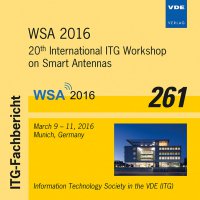Experimental Evaluation of 5G Modulation Schemes in Quasi-Static Scenarios
Conference: WSA 2016 - 20th International ITG Workshop on Smart Antennas
03/09/2016 - 03/11/2016 at München, Deutschland
Proceedings: WSA 2016
Pages: 8Language: englishTyp: PDF
Personal VDE Members are entitled to a 10% discount on this title
Authors:
Dominguez-Bolano, Tomas; Rodriguez-Pineiro, Jose; Garcia-Naya, Jose A.; Castedo, Luis (University of A Coruna, A Coruna, Spain)
Abstract:
Orthogonal Frequency-Division Multiplexing (OFDM) is a widely used modulation scheme in wireless communications due to its robustness against channel multi-path. Unfortunately, the time-domain rectangular-shape of the OFDM-modulated symbols yields a frequency response with high side lobes, thus producing co-channel interference. More recently, Filter Bank Multicarrier (FBMC) modulation schemes have been proposed as an alternative to OFDM due to their better spectral efficiency and more degrees of freedom to define well localized prototype filters. In this paper, the performance of two common prototype filters for an FBMC scheme, known also as Staggered Multitone (SMT), is analyzed analytically and by means of computer simulations considering standardized channel models. The results are also compared to OFDM. Finally it is experimentally evaluated through over-the-air transmissions in different environments using a custom-developed testbed. Performance results, in terms of the Bit Error Ratio (BER) with respect to the average signal-to-noise ratio, show a similar performance for OFDM and FBMC in all the cases. This is mainly because the considered channel models and measurement scenarios are quasi-static and we have considered an isolated point-to-point link, thus not including potential advantages of FBMC schemes, which can be exploited without additional performance losses with respect to OFDM.


